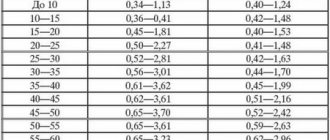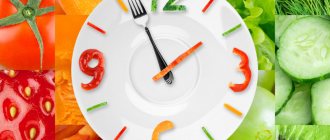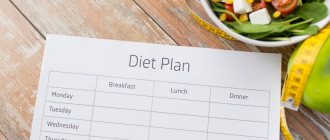The problem of excess weight is becoming more and more urgent. Every year the number of people suffering from obesity is growing steadily. And this is a scary statistic. But at the same time, healthy eating and exercise are becoming increasingly popular. A beautiful body, a fit, slender figure are today synonymous with human success.
Many people, planning to lose excess ballast, subject their body to serious physical overload in combination with a strict diet or, even, fasting. This approach to weight normalization leads to dangerous health consequences.
Instead of abs, you can get gastritis, ulcers or gastric obstruction. You can’t rush; you need to choose a rational training and nutrition plan for weight loss.
Making the right diet
Exercising alone is not enough to lose weight. If you overeat at night and eat only fast food, then no amount of jogging or going to a fitness center will help you. The first thing to do is balance your daily menu.
To lose weight, you don’t need to starve and torment your body with strict restrictions. There is a “golden” rule of diet: eat fewer calories than you burn in a day.
The main mistake of many losing weight is giving up fats and proteins. In fact, these elements are necessary for the body. Without them, there will be a decrease in muscle mass, and not a loss of fat on the stomach and sides. Most nutritionists agree that eggs, fermented milk products, hard cheeses, lean meat, fish and seafood must be included in your diet.
Sample menu for the day:
Breakfast - a portion (100-150 grams) of cottage cheese and coffee.
Snack - a couple of whole grain breads and yogurt.
Lunch - vegetable salad dressed with olive oil, boiled chicken (200g), side dish (buckwheat porridge, rice) and fruit for dessert.
Afternoon snack - steamed cutlet (about 100 grams) and a few spoons of porridge.
Dinner - baked fish (preferably sea fish), steamed green beans and any juice.
Of course, the products described may not be suitable for everyone, but this daily diet contains all the vitamins and minerals our body needs.
It is very important not to forget about water balance. You need to drink often and a lot. You cannot bring the body to dehydration and exhaustion. The daily norm for a person weighing about 80-90 kilograms is 1.5-2 liters, and this does not include soups, juices or compotes.
Pros and cons of a meal plan
This approach has its positive and negative sides. Let's look at the main ones.
Meal Plan: Pros
- Saving time on cooking and purchasing groceries . It has been noticed that those who plan their diet and buy food according to it spend much less time shopping and cooking. By making a meal plan for the week and purchasing everything you need in advance, you don’t have to worry about what to cook for each meal, and you can also prepare healthy frozen semi-finished products: chopped vegetables, portioned pieces of meat or fish.
- Nothing extra . A well-thought-out meal plan allows you to eat exactly as much as planned. At the same time, there will be no temptation to eat any foods that are not included in the calculated diet.
- Money saving . After you carefully plan your diet, you will not be tempted to go to a cafe or eat fast food, which is quite expensive and brings questionable benefits. There will be no desire to buy something “tasty”, but obviously unnecessary.
- Improved energy performance . By calculating the weekly and daily caloric intake, as well as the optimal content of proteins, fats and carbohydrates in the daily food intake, you can distribute the consumption of all micro- and macroelements evenly throughout the day. As a result, you will avoid such troubles as a sharp increase in sugar levels, ketosis, overwork, and will also be able to achieve better weight loss results.
- Stability . By adhering to a proper nutrition plan, it will be much easier to control your own weight and reduce the likelihood of breaking the established regime.
Disadvantages of a Meal Plan
- Difficulties in communication . Our culture involves communication while eating: this includes gatherings with a friend over a cup of tea or coffee, a business meeting in a cafe, a family visit to a restaurant, a picnic in nature, and much more. Feasts accompany any holiday. It is quite difficult to control what is eaten during joint feasts, so those who adhere to a nutrition plan subconsciously avoid communication if it is associated with eating together.
- Breakdowns and guilt . If your meal plan is rigid, it will become quite difficult to stick to it. If deviations arise, there is a high probability that you will begin to feel guilty for this and at some point you will say to yourself: “How much is possible?! Enough!" – and you will return to disordered eating again. To avoid this situation, it is better to allow some flexibility when planning, without setting rigid meal times or limiting the range of products.
- Monotony . By finding several foods or creating recipes for dishes with the “optimal” ratio of nutrients, you run the risk of eating the same dishes for days or even weeks on end. But finding products that contain all the substances the body needs is almost impossible.
Interesting: The mechanism of appetite is set by nature in such a way that a person constantly wants to try something new. Variety in food is necessary not only to nourish the body properly, but also to experience satisfaction from food. By eating monotonous food, you can eventually lose the ability to enjoy it, which inevitably leads to a breakdown. Take this into account when buying a set of groceries for the week.
Floor
Proper nutrition depends on gender. We are not built the same, so nutrition should be selected taking into account gender differences. For example, women have a smaller set of muscle fibers than men. This means that we have different daily calorie needs:
- Women's energy needs are from 1500 kcal/day.
- Men's energy needs range from 2300-2400 kcal/day.
Calories are the energy we expend and get from food. When calculating calories, gender, type of activity and weight are taken into account. The more you weigh, the more calories you need. For example, you have an extra 10 kilograms of weight, and it’s the same as if you carry dumbbells with that weight. This means you spend more energy.
When drawing up a nutrition plan, we do not limit ourselves to just counting calories, but try to maintain the ratio of BZHU and calculate the individual needs for men and women for proteins, fats and carbohydrates.
When a man says he needs more meat, he's right

- Men's protein requirement is 2 g per 1 kg of weight.
- Women's protein requirement is 1 g per 1 kg of weight.
Let's say a man weighs 85 kg and leads an active lifestyle. We multiply his body weight by 2 g of protein and get 170 g of the daily requirement. In calories it is 680 kcal. In one meal, a man can consume up to 20 g of protein: this is contained in 3 eggs, 75 g of tuna, 100 g of chicken fillet.
However, you should not increase your meat consumption in order to gain muscle mass. Our body is able to absorb no more than 20 grams of protein food at one time. If you eat 30 grams in one sitting, then not only will it not be useful for future use, but it can harm the body.
Next we calculate the rest:
- A man's need for carbohydrates is 3-5 g per 1 kg of weight.
- Women's need for carbohydrates is 3 g per 1 kg of weight.
- A man's need for fat is 1 g per 1 kg of weight (no more than 100 g per day and no less than 50 g).
- Women's need for fat is 1 g per 1 kg of weight (no more than 100 g per day and no less than 50 g).
Energy value:
- Proteins 1 g – 4 kcal.
- Carbohydrates 1 g – 4 kcal.
- Fats 1 g – 9 kcal.
It turns out that our exemplary man, who weighs 85 kg, needs 2465 kcal per day, of which 170 g of protein, 85 g of fat, 225 g of carbohydrates.
the formula for calculating the needs for KBZHU for you , then use an online calculator.
How to eat every day
In conclusion, I will give some short tips on how to eat every day to avoid problems with the gastrointestinal tract and health.
- Eat without being distracted by anything, be it social media news or an interesting conversation with a friend. I highly recommend that those who eat quickly or on the go read Thich Nan Han's book How to Eat Mindfully .
- Chew food thoroughly and do not swallow large pieces.
- Eat 1.5 hours before physical activity. If you have a gym class or jogging soon, then do not load your gastrointestinal tract, otherwise you may get unpleasant cramps in your tummy.
- Overeating - no. Eat slowly, taking time to pause between meals to determine when you are full.
- Do not injure your body by fasting, unless you are advised to do so as part of your treatment.
- Drink water during meals. It's okay to drink water with your meal, but not juice, coffee, or anything else.
- Cook it yourself. While we cook, a signal is sent to the brain that configures our digestive tract to accept the food that we see. When you start eating it, your body already has enzymes ready to digest these particular foods.
- And, of course, food should be a pleasure. Who said that diet food has to be tasteless! It is a myth. In this article you will find several interesting recipes for weight loss. If you have any dietary weaknesses, for example, you cannot live without sprats or dumplings, then allow yourself these dishes without excess at a certain time. And of course, buy only quality products.
Ksenia Vavilova
Illustrations: depositphotos.com
What is a nutrition program and why is it important?

There is a principle - to lose weight, you need to spend more calories daily than you consume. On the one hand, this is not difficult to achieve. On the other hand, you will have to make enormous efforts to achieve such a simple task. After all, in practice everything turns out to be more complicated than in theory.
A specially designed program is important because it helps you eat a balanced diet. Its goal is to force the body to absorb 100% of substances that it normally absorbs 20-30%. And this is undoubtedly a huge advantage. The plan helps save time and money, everything is clear with it. But there is another side of the coin that should never be forgotten - the disadvantages. Therefore, after familiarizing yourself with the topic, ask yourself the question - do I need this?
Eating according to the program is a huge amount of self-control. To hold out, eat what is written in the notebook, and not send everything to hell - that’s what you need to be prepared for. The meal plan can be disrupted by going to a restaurant with your significant other or going to a friend’s birthday party, it can lead to nervous breakdowns, it lacks variety, but there is regularity, which will make you, figuratively speaking, sick after just half a day. And lack of knowledge can play a cruel joke. After all, a nutrition plan doesn’t always work—it only takes one tiny mistake.
Basic Rules

- Prioritization. Simply put, determining the daily calorie content, personal norm of dietary fat and microelements. Here the main guideline is the composition of the product, and not its taste. By the way, you can forget about “I love” and “I will never eat” - they are superfluous in the nutrition program.
- Determining the number of meals per day. Here you should not rely on the fact that nutritionists advise eating 5-7 times a day. Here it is important to make the number of meals such that a person is sure that at this time he will be able to have breakfast/snack/lunch/dinner. That is, it is important to take into account the work schedule and some other personal aspects.
- The right choice of products. One great fitness expert recommends giving up to 10% of your daily diet to your favorite foods. Even if it’s the same wildly harmful fast food, the risk of losing your temper and spoiling your nerves is reduced many times over! The remaining 80-90% should be given to healthy foods, which include vegetables, fish, meat, cereals, fruits, nuts, cereals, and so on.











